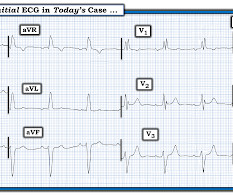ECG Blog #394 — Is QRS Morphology Disguised?
Ken Grauer, MD
SEPTEMBER 8, 2023
The ECG in Figure-1 — was obtained from an older man with a history of prior infarction and coronary bypass surgery. How would you interpret this tracing? Clinical implications? Figure-1: The ECG in today's case. ( To improve visualization — I've digitized the original ECG using PMcardio ). MY Thoughts on the ECG in Figure-1: The rhythm in ECG #1 is sinus at ~65/minute — with an upright P wave in lead II, and a constant and normal PR interval (ie, not more than 0.21 second in duration ).











Let's personalize your content